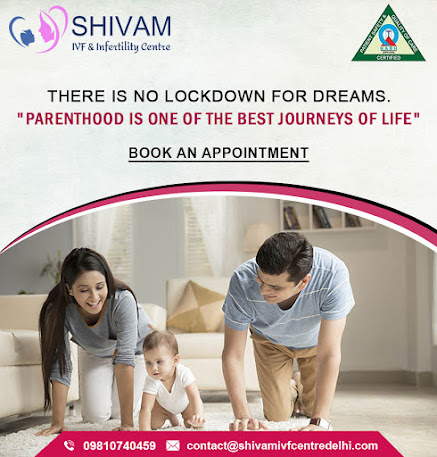A Step-by-Step Guide About the IVF Procedure!
In vitro fertilization (IVF) is probably near the top of your list of common fertility treatments. There's a good reason for this. IVF has been around for decades, and you've probably heard of the basic concept: combining egg and sperm outside of the body in culture. But there is a lot more to IVF that occurs both before and after that. Here's a five-step breakdown of the IVF process.
IVF is frequently used to treat:
1. Women over the age of fifty
who are experiencing fertility issues.
2. Women who have clogged or
damaged fallopian tubes
3. Endometriosis sufferers
4. Male infertility is caused by
sperm count deficiency or blockage
The IVF Procedure in Five Easy Steps
1.
Increase your egg production
by superovulating:
According
to the National Institutes of Health, fertility drugs will be administered to
you to initiate a process known as stimulation — or superovulation (NIH). In
other words, the drugs, which contain Follicle Stimulating Hormone, will
instruct your body to produce more than the standard one egg per month. The
more eggs you produce, the more likely successful fertilization will be later
in the treatment.
During
this stage of the IVF process, you'll have transvaginal ultrasounds and blood
tests on a regular basis to check on your ovaries and monitor your hormone
levels.
2.
Take out the eggs:
A
hormone injection will be given to you for a little more than a day since your
eggs are scheduled to be extracted from your body. This will help your eggs
mature quickly. The eggs will then be removed via a minor surgical procedure
known as follicular aspiration. According to the NIH, this is usually done as
an outpatient surgery in your doctor's office.
During
the process, your doctor will apply ultrasound to direct a thin needle through
your vagina to each of your ovaries. A device attached to the needle suctions
the eggs out one by one.
Don't
worry if this sounds painful; you'll most likely be provided with medication
beforehand to relieve any discomfort.
3.
Obtain sperm from a partner
or a donor:
While
your eggs are being extracted, your partner will give you a sperm sample. You
can also use donor sperm if you prefer. The sperm are then washed and spun at
high speeds to identify the healthiest ones.
4.
Combine sperm and eggs:
Now
comes the most well-known aspect of IVF: combining the best sperm with your
best eggs. This is known as insemination.
A
sperm usually takes a few hours to fertilize an egg. Instead, your doctor may
inject the sperm directly into the egg, a procedure known as intracytoplasmic
sperm injection (ICSI).
5.
Inject the embryo(s) into
your uterus.
You
will be given yet another medication after your eggs have been collected. This
one is designed to prepare your uterine lining for the embryos that will be
transferred back into you. Your doctor will use a catheter to locate the
embryos in your uterus three to five days after fertilization. This part of
IVF, like step three, is done while you are awake in your doctor's office.
Multiple
embryos are transferred back into you with the goal that at least one will
implant and develop in the lining of your uterus. Multiple embryos can embed at
the same time, which is why IVF patients frequently have multiples.
Do
you want to learn more about IVF or find out if you are suitable for assisted
reproductive technology? Please contact Shivam IVF to schedule a consultation.
Shivam IVF is here to help you make the best decision and take the necessary
steps to improve your fertility.
In
vitro fertilization (IVF) is probably near the top of your list of common
fertility treatments. There's a good reason for this. IVF has been around for
decades, and you've probably heard of the basic concept: combining egg and
sperm outside of the body in culture. But there is a lot more to IVF that
occurs both before and after that. Here's a five-step breakdown of the IVF
process.
IVF is frequently used to treat:
1. Women over the age of fifty
who are experiencing fertility issues.
2. Women who have clogged or
damaged fallopian tubes
3. Endometriosis sufferers
4. Male infertility is caused by
sperm count deficiency or blockage
The IVF Procedure in Five Easy Steps
1.
Increase your egg production
by superovulating:
According
to the National Institutes of Health, fertility drugs will be administered to
you to initiate a process known as stimulation — or superovulation (NIH). In
other words, the drugs, which contain Follicle Stimulating Hormone, will
instruct your body to produce more than the standard one egg per month. The
more eggs you produce, the more likely successful fertilization will be later
in the treatment.
During
this stage of the IVF process, you'll have transvaginal ultrasounds and blood
tests on a regular basis to check on your ovaries and monitor your hormone
levels.
2.
Take out the eggs:
A
hormone injection will be given to you for a little more than a day since your
eggs are scheduled to be extracted from your body. This will help your eggs
mature quickly. The eggs will then be removed via a minor surgical procedure
known as follicular aspiration. According to the NIH, this is usually done as
an outpatient surgery in your doctor's office.
During
the process, your doctor will apply ultrasound to direct a thin needle through
your vagina to each of your ovaries. A device attached to the needle suctions
the eggs out one by one.
Don't
worry if this sounds painful; you'll most likely be provided with medication
beforehand to relieve any discomfort.
3.
Obtain sperm from a partner
or a donor:
While
your eggs are being extracted, your partner will give you a sperm sample. You
can also use donor sperm if you prefer. The sperm are then washed and spun at
high speeds to identify the healthiest ones.
4.
Combine sperm and eggs:
Now
comes the most well-known aspect of IVF: combining the best sperm with your
best eggs. This is known as insemination.
A
sperm usually takes a few hours to fertilize an egg. Instead, your doctor may
inject the sperm directly into the egg, a procedure known as intracytoplasmic
sperm injection (ICSI).
5.
Inject the embryo(s) into
your uterus.
You
will be given yet another medication after your eggs have been collected. This
one is designed to prepare your uterine lining for the embryos that will be
transferred back into you. Your doctor will use a catheter to locate the
embryos in your uterus three to five days after fertilization. This part of
IVF, like step three, is done while you are awake in your doctor's office.
Multiple
embryos are transferred back into you with the goal that at least one will
implant and develop in the lining of your uterus. Multiple embryos can embed at
the same time, which is why IVF patients frequently have multiples.
Do you want to learn more about IVF or find out if you are suitable for assisted reproductive technology? Please contact Shivam IVF to schedule a consultation. Shivam IVF is here to help you make the best decision and take the necessary steps to improve your fertility.
Source:- https://shivamivfcentredelhi.com/blog-details/a-step-by-step-guide-about-the-ivf-procedure-




Comments
Post a Comment